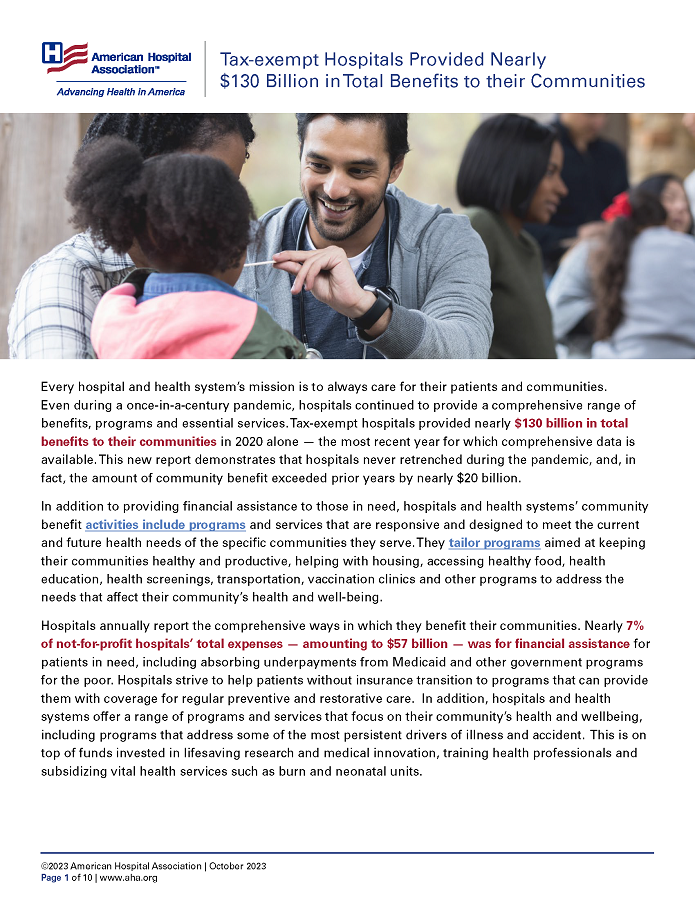

Results from 2020 Tax-Exempt Hospitals’ Schedule H Community Benefit Reports
Tax-exempt Hospitals Provided Nearly $130 Billion in Total Benefits to their Communities

Every hospital and health system’s mission is to always care for their patients and communities. Even during a once-in-a-century pandemic, hospitals continued to provide a comprehensive range of benefits, programs and essential services. Tax-exempt hospitals provided nearly $130 billion in total benefits to their communities in 2020 alone — the most recent year for which comprehensive data is available. This new report demonstrates that hospitals never retrenched during the pandemic, and, in fact, the amount of community benefit exceeded prior years by nearly $20 billion.
In addition to providing financial assistance to those in need, hospitals and health systems’ community benefit activities include programs and services that are responsive and designed to meet the current and future health needs of the specific communities they serve. They tailor programs aimed at keeping their communities healthy and productive, helping with housing, accessing healthy food, health education, health screenings, transportation, vaccination clinics and other programs to address the needs that affect their community’s health and well-being.
Hospitals annually report the comprehensive ways in which they benefit their communities. Nearly 7% of not-for-profit hospitals’ total expenses — amounting to $57 billion — was for financial assistance for patients in need, including absorbing underpayments from Medicaid and other government programs for the poor. Hospitals strive to help patients without insurance transition to programs that can provide them with coverage for regular preventive and restorative care. In addition, hospitals and health systems offer a range of programs and services that focus on their community’s health and wellbeing, including programs that address some of the most persistent drivers of illness and accident. This is on top of funds invested in lifesaving research and medical innovation, training health professionals and subsidizing vital health services such as burn and neonatal units.
Executive Summary
Improving the health of their communities is at the heart of every hospital’s mission.
Tax-exempt hospitals annually demonstrate accountability to the communities they serve by reporting to Internal Revenue Service (IRS) on the benefits they provide to their community using the IRS Form 990 Schedule H and making it publicly available. This report summarizes such community benefit information for the tax year 2020.*
Tax-exempt hospitals provide benefits to their communities in a multitude of ways, only some of which is captured by the IRS Form 990 Schedule H. They offer programs and activities to:
- Improve community health by addressing pressing health and wellness needs
- Underwrite medical research and health professions education
- Subsidize many high-cost, essential health services
In addition, they provide financial assistance and absorb underpayments from meanstested government programs to aid those in need, such as Medicaid, as well as incur losses due to unreimbursed Medicare expenses and bad debt expenses that are attributable to financial assistance.
Table 1 shows a snapshot of the benefits tax-exempt hospitals provide to their communities. In 2020, these hospitals and health systems reported total community benefits of over $129 billion, or 15.5% percent of total expenses, half of which resulted from expenditures for financial assistance for patients and absorbing losses from Medicaid and other means-tested government program underpayments. It is of particular note that the amount of community benefit increased from that reported the previous year by almost $20 billion, despite hospitals battling an unprecedented national pandemic.
Table 1. Financial Assistance and other benefits to the community (average percent of total expense)
| Type of Benefit | 2020 |
|---|---|
| Financial Assistance, unreimbursed Medicaid, and other unreimbursed costs from means-tested government programs | 6.9% |
| Total Benefits to the Community | 15.5% |
| Note: Percentages are based on actual reported costs, not charges. (2,790 Hospitals) | |
This report presents the financial costs incurred by tax-exempt hospitals and health systems in providing community benefits. IRS requires such hospitals to report community benefit as a percent of hospital expenses. These numbers alone, however, do not measure the value of the overall tangible and intangible benefits hospitals provide by improving their communities’ health and economic well-being. Tax-exempt hospitals also provide the IRS descriptions of their community benefit programs as part of their filing that begin to tell the hospital’s story beyond what can be learned from the financial information alone. They also engage in a regularly scheduled process, in conjunction with their communities, to develop a plan to tackle the greatest health and wellness needs culminating in a formal Community Health Needs Assessment.
*(Tax year for which the most recent comprehensive filed information is available.)


